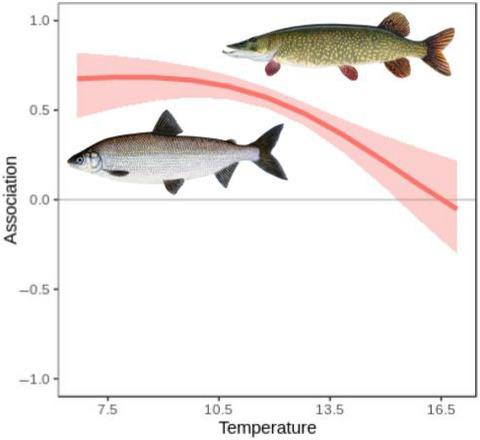当前位置:
X-MOL 学术
›
Glob. Change Biol.
›
论文详情
Our official English website, www.x-mol.net, welcomes your
feedback! (Note: you will need to create a separate account there.)
Modelling temperature-driven changes in species associations across freshwater communities
Global Change Biology ( IF 10.8 ) Pub Date : 2021-10-20 , DOI: 10.1111/gcb.15888 Sam Wenaas Perrin 1 , Bert van der Veen 2, 3 , Nick Golding 4, 5, 6 , Anders Gravbrøt Finstad 1
Global Change Biology ( IF 10.8 ) Pub Date : 2021-10-20 , DOI: 10.1111/gcb.15888 Sam Wenaas Perrin 1 , Bert van der Veen 2, 3 , Nick Golding 4, 5, 6 , Anders Gravbrøt Finstad 1
Affiliation

|
Due to global climate change–induced shifts in species distributions, estimating changes in community composition through the use of Species Distribution Models has become a key management tool. Being able to determine how species associations change along environmental gradients is likely to be pivotal in exploring the magnitude of future changes in species’ distributions. This is particularly important in connectivity-limited ecosystems, such as freshwater ecosystems, where increased human translocation is creating species associations over previously unseen environmental gradients. Here, we use a large-scale presence–absence dataset of freshwater fish from lakes across the Fennoscandian region in a Joint Species Distribution Model, to measure the effect of temperature on species associations. We identified a trend of negative associations between species tolerant of cold waters and those tolerant of warmer waters, as well as positive associations between several more warm-tolerant species, with these associations often shifting depending on local temperatures. Our results confirm that freshwater ecosystems can expect to see a large-scale shift towards communities dominated by more warm-tolerant species. While there remains much work to be done to predict exactly where and when local extinctions may take place, the model implemented provides a starting-point for the exploration of climate-driven community trends. This approach is especially informative in regards to determining which species associations are most central in shaping future community composition, and which areas are most vulnerable to local extinctions.
中文翻译:

模拟淡水群落中物种关联的温度驱动变化
由于全球气候变化引起的物种分布变化,通过使用物种分布模型估计群落组成的变化已成为一种关键的管理工具。能够确定物种关联如何沿环境梯度变化可能对于探索物种分布的未来变化幅度至关重要。这在连通性有限的生态系统中尤为重要,例如淡水生态系统,在这些生态系统中,人类易位的增加正在创造物种关联,而不是以前看不见的环境梯度。在这里,我们在联合物种分布模型中使用来自芬诺斯坎迪亚地区湖泊的淡水鱼的大规模存在-不存在数据集,来测量温度对物种关联的影响。我们确定了耐受冷水的物种与耐受温暖水域的物种之间存在负关联的趋势,以及几种更耐热的物种之间存在正关联,这些关联通常会根据当地温度而变化。我们的结果证实,淡水生态系统有望大规模转向以更耐热的物种为主的群落。虽然要准确预测局部灭绝可能发生的地点和时间还有很多工作要做,但实施的模型为探索气候驱动的社区趋势提供了一个起点。这种方法在确定哪些物种关联在塑造未来群落组成方面最重要以及哪些地区最容易受到当地灭绝的影响方面特别有用。
更新日期:2021-12-03
中文翻译:

模拟淡水群落中物种关联的温度驱动变化
由于全球气候变化引起的物种分布变化,通过使用物种分布模型估计群落组成的变化已成为一种关键的管理工具。能够确定物种关联如何沿环境梯度变化可能对于探索物种分布的未来变化幅度至关重要。这在连通性有限的生态系统中尤为重要,例如淡水生态系统,在这些生态系统中,人类易位的增加正在创造物种关联,而不是以前看不见的环境梯度。在这里,我们在联合物种分布模型中使用来自芬诺斯坎迪亚地区湖泊的淡水鱼的大规模存在-不存在数据集,来测量温度对物种关联的影响。我们确定了耐受冷水的物种与耐受温暖水域的物种之间存在负关联的趋势,以及几种更耐热的物种之间存在正关联,这些关联通常会根据当地温度而变化。我们的结果证实,淡水生态系统有望大规模转向以更耐热的物种为主的群落。虽然要准确预测局部灭绝可能发生的地点和时间还有很多工作要做,但实施的模型为探索气候驱动的社区趋势提供了一个起点。这种方法在确定哪些物种关联在塑造未来群落组成方面最重要以及哪些地区最容易受到当地灭绝的影响方面特别有用。











































 京公网安备 11010802027423号
京公网安备 11010802027423号